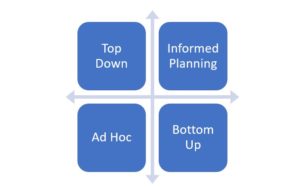Setting Strategy – What Works for Law Firms?
 As we wind down another year, many firms are turning to a discussion of the coming year and setting or resetting firm strategy and goals for the future. We continue to see firms use a variety of approaches in setting strategy. These approaches vary along two principal dimensions: 1) level of partner input and 2) level of organizational process applied.
As we wind down another year, many firms are turning to a discussion of the coming year and setting or resetting firm strategy and goals for the future. We continue to see firms use a variety of approaches in setting strategy. These approaches vary along two principal dimensions: 1) level of partner input and 2) level of organizational process applied.
Level of Partner Input: Strategy approaches which are high on partner input solicit views on the firm’s direction in a formal way through surveys, focus groups and/or partner interviews. By contrast, approaches which are low on partner input do not engage partners in a dialogue about the firm’s direction in an organized or purposeful way.
Level of Organizational Process: Strategy approaches which are high in organizational process tend to set strategy in a more rigorous way, contemplating both internal and external dynamics and gathering significant research and intelligence on market trends, including client expectations and requirements and competitor moves. Approaches low on organizational process tend to set strategy without a clear understanding of the external marketplace and are more inwardly focused.
In the following chart, we have mapped the broad approaches to setting strategy observed in law firms based on these two primary variables.
Approaches to Setting Strategy in Law Firms
In our experience, we find that depending on the nature of the firm, its partnership, practice mix and market position, some of these approaches deliver more value than others.
Top Down: In some firms, the firm’s primary leaders, either the Chair/Managing Partner or the Executive Committee, will define a strategy for the firm without soliciting partner input on the firm’s direction or goals in an organized or comprehensive way. For some firms with a highly specialized practice and with concentrated geographies, the Top Down approach may work, as the resulting strategy is really a statement of what the firm has already achieved in terms of market position. It may also be appropriate for firms who are revisiting a well-developed strategy. However, for firms seeking greater movement in market position or needing to make more significant internal changes, this approach may produce little to no buy-in and result in limited meaningful change in behavior among partners. As partnerships, law firm partners rightfully expect some level of input into the direction of their business. Processes which do not allow for partner involvement often result in strategies which lack support from the partnership, fail to gain traction, and consequently, fail to deliver tangible results.
Bottom Up: At the opposite end of the spectrum, a Bottom Up strategy involves a process in which a larger group of non-leader lawyers (typically partners but some firms do involve associates) seek to define a strategy for the firm. While useful for involving partners and gathering partner input, these processes are often ill-defined in terms of organizational process and lack a more detailed analysis of where the firm is currently positioned in the market or sufficient intelligence about emerging client and competitor trends. As a result, the resulting strategy may be misinformed and unrealistic, or heavily internally focused. A further challenge, the lack of leadership involvement tends to result in a lack of buy-in at the top. Without commitment from leadership to the strategy, these plans regularly collect dust on office shelves and unfortunately result in very little implementation activity.
Ad Hoc: While most mid-size and large firms have adopted more specific and focused strategies over the past decade, some firms continue to operate without a clearly defined strategy. An Ad Hoc strategy approach is one which is loosely defined and morphs from one decision to the next. These firms do not seek to cultivate partner dialogue or reach a definition of the firm’s targeted market position or goals for the future. Often times, this approach results from weak leadership or a desire to avoid confronting a misalignment of practices, client segments, geographic platform, or overall market position. As a result, firms relying on an Ad Hoc approach to strategy development make short term decisions on growth and management without a coherent view of where the firm aims to compete or position itself over the long term, often leading to further dilution in market position.
Informed Strategic Planning: Under an Informed Strategic Planning approach, firms seek to achieve the right balance in terms of both organizational process and partner input. A key component of this approach involves an effective Strategic Planning Committee, which is typically comprised of a cross-section of key firm leaders and other high value, partner influencers. The composition of this Committee is central to ensuring a combination of leadership involvement and buy-in in setting strategy, as well as reaching and communicating with a broader group of partners through the involvement of those selected to serve.
Once formed, this Committee will engage in the critical components of organizational process. They will invest substantial time and energy in gathering information on current industry trends, competitor dynamics, and most importantly, client demand for services. While time and resource consuming, client interviews provide invaluable insight into the market’s perception of a firm, the firm’s position relative to primary competitors, and client demand trends. Firms also find value in gathering data from other external sources, such as industry surveys, market research, peer and competitor analyses, etc.
Once client input and market and competitor research has been gathered, the Committee will need to formulate a deep understanding of the firm’s current position in the marketplace by looking at both the firm’s relative market position and internal dynamics. This is often best accomplished by soliciting partner input. Typically, firms conduct partner interviews, focus groups, an online survey, or some combination thereof to understand partner perspectives on where the firm is today and partner goals for the firm’s future. This feedback is augmented by financial and practice analyses to round out the ‘story’ of the firm’s current position. Having invested time in both organizational process and partner input, the Strategic Planning Committee is more effectively positioned to identify the range of potential strategic options for the future.
As firms commence the difficult task of evaluating the options and agreeing upon the right strategy, a key to success is continuing to bring partners along in the process. While seeking initial input is valuable, it is just as important to maintain regular communication with partners as the Committee reaches conclusions on direction and starts to craft the core elements of the firm’s strategy.
Overall, Informed Strategic Planning tends to be the most successful approach to strategy development in law firms looking for real change, as it leads to setting strategy based on a greater knowledge of the firm’s external and internal dynamics and produces the greatest level of partner buy-in. In turn, the combination of these factors improves the likelihood and success of implementation.


